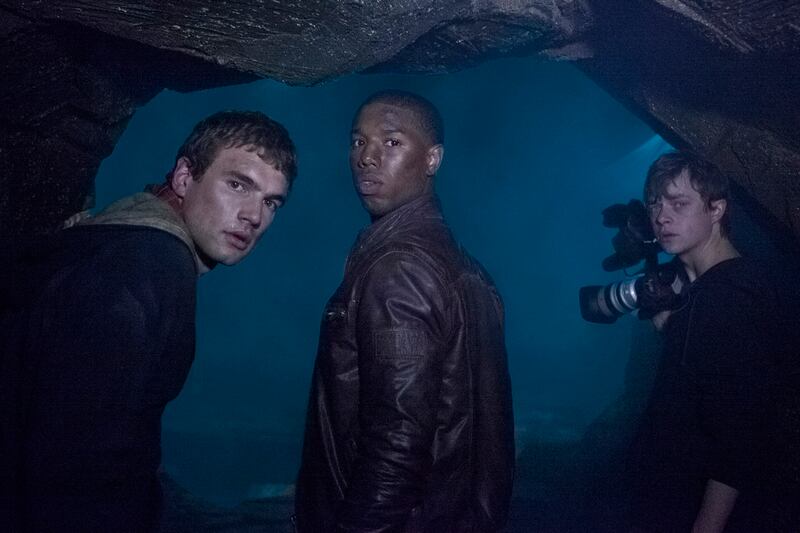As a young television actor, Michael B. Jordan broke hearts when his character died on The Wire; won over Pine Valley on All My Children as a troubled kid who gets his act together; soared as a high-school quarterback on Friday Night Lights; and touched viewers as a young man struggling to thrive despite massive odds on Parenthood.
Now Jordan, who turns 25 next week, is in two feature films—as a fighter pilot in Red Tails and as a cocky teenage athlete who develops superpowers in the new science-fiction film Chronicle, which opens Friday. Red Tails, released last month, gave Jordan a rare opportunity to share a slice of African-American history; Chronicle allowed him to get in touch with his inner geek and play pretend on a new level.
“I just want to do good work that I can be proud of and that keeps other people entertained,” Jordan says. “Whether that’s a new TV pilot or a big blockbuster film, that’s what I want to do. But I must admit it was fun doing these movies. There’s something different about having a character with a beginning and end rather than going week to week, season to season, somewhat knowing where your character’s going and trying to pace it out.”
In George Lucas’s passion project Red Tails—a historical epic based on the highly decorated squadron of African-American pilots known as the Tuskegee Airmen, who defied racist limitations by flying thousands of missions during World War II—Jordan took on eager aviator Maurice “Bumps” Wilson. Jordan says he was moved to audition because “as a black male in Hollywood, you only get so many scripts where you get to portray and glorify our history.”

Shot in Croatia and the Czech Republic, Red Tails also marked the first time Jordan went on location for a movie. To prepare, he and the others who played the young Air Force pilots spent two weeks in a boot camp immersed in the real-life routines of the Tuskegee Airmen in the 1940s. Living in an abandoned factory with no running water, the actors had to line up in formation and march for a mile in the snow to shower.
“We ate what they ate,” Jordan says. “We had their routine down, their workout regimen, that’s exactly what we did. And trust me, they went through a lot. It was just two weeks, but it felt like two months. We slept on cots, and there were only three showers. Because we had to allot time to march to the showers and back, sometimes we wouldn’t shower for the better of the squad, because if we were late we would have to work out extra. So sometimes I’d just hang off. It was intense, man.”
Although Chronicle also called for three weeks of physical training and team-building exercises that included Jordan and the other two leads, Dane DeHaan (In Treatment) and Alex Russell, sharing a house in Cape Town, South Africa, the mood on the set “almost felt like we’d get to work so we could start playing,” Jordan says. The anticipated film by first-time director Josh Trank tells the story of three high-school students who bond after encountering a mysterious force and developing the superhuman abilities of telekinesis and flight. Because boys will be boys, the movie explores what happens to those powers in the hands of adolescents.
“We wanted to make it as real as possible,” Jordan says. “If you’re in high school and you realize you have these abilities, what would you do? How would you react? We wanted to touch base on everything—the jokes, the girls, pranking on each other. And then the rest of it, the realistic things that can happen when you use the powers to change things in your life.”
The movie, which Trank co-wrote with Max Landis, departs from the typical superhero tale in ways that can’t be revealed without spoiling it, but Trank’s filmmaking tricks lend Chronicle a fresh perspective. When the film opens, the central character, Andrew (DeHaan), has decided to document everything in his life with his camera, creating a barrier between himself and his world. Through those scenes, the audience might assume that Chronicle is standard found-footage fare (a genre of filmmaking in which most or all of a movie is presented as discovered video or audio recordings). But as the story develops, and Andrew discovers he is telekinetic, he harnesses his new powers to improve his filmmaking. It’s as if Andrew’s camera has its own superpower and its own story arc.
“That’s what swept me away about the script,” Jordan says. “It is not being documented like found footage. You feel like a fly on the wall. We used a lot of first-time filmmaking techniques, and we’re very proud of that. But come on, I grew up watching cartoons, and I’m a big comic-book fan. Playing a character with superpowers? I’m all for it.”
His experience on NBC/DirecTV’s Friday Night Lights, which was filmed with three cameras running all the time and no rehearsals, helped Jordan sort out how to best play Steve, a popular athlete whose every move is being tracked by Andrew’s unrelenting camera. Their living arrangement during the shoot, coupled with trust and memory exercises a producer forced the three actors to do, made it easier to establish a credible camaraderie and fall in step with the camera that took the place of a fourth character throughout the movie. They underwent high-wire training and stunt classes as well as the three weeks of physical training to prepare for their favorite part of the job: the flying sequences.
“We were trying to pull it off as if Steve was a real person, not a character, if that makes any sense,” Jordan says. “These are real kids, like anybody else out there with a camera that can document their lives. It’s kind of that gray area between playing the actual character in the movie and trying to make it as real as possible, where it didn’t feel like a movie. That was kind of a challenge for me, but once we got into it, it just kind of happened. We have to thank Adam Schroeder, our producer, for all the stuff he made us do. It was the corniest shit ever and seemed so stupid at the time, but once we started shooting, we had all these inside jokes and a bond we’d established.”
As part of two of the most memorable primetime series on TV in recent years, Jordan knows the value of connecting with his fellow actors. On the first season of HBO’s The Wire he played Wallace, a sweet kid who gets mixed up in the drug trade, winds up as a police informant, and is killed by his two best friends in the gang. Fans of the show’s realistic take on Baltimore’s urban life vividly remember Wallace’s pleas for mercy before his buddies shot him.
“Wallace was so raw, innocent, very new to the grittiness of the streets, of the dope game, he wasn’t built for that world—the killing and the snitching,” says Jordan, who was 14 when he took the job. “He represents the beginning of my career, and he reflected a big part of me because I myself was so raw. People still stop me on the street and ask about Wallace, and they tell me they’ve been watching Season 1 again and that I had them crying. For people to still remember that and still be touched by that, it means the world to me.”
Jordan joined NBC’s Friday Night Lights for its last two seasons as an athletic kid from the wrong side of town who is given the choice to either play high-school football or go to juvenile detention. The son of an imprisoned father and drug-addicted mother, Vince Howard just needs a chance—which he gets from Coach Eric Taylor (Kyle Chandler) and winds up becoming a coveted star quarterback.
“These kids in these situations—Mom’s on drugs, Dad’s not around—those are stereotypes, but they happen and they exist,” Jordan says. “So when I have an opportunity to change a person’s way of thinking about a particular person or race, I try to do that. Vince had it rough growing up, but he still made good choices, and I tried to show Vince making the most realistic choices that he can make at the time. It’s like hiding the medicine in the food, almost. If I could hide the message in the art, if I could change one person’s thinking, then I feel I did my job.”






